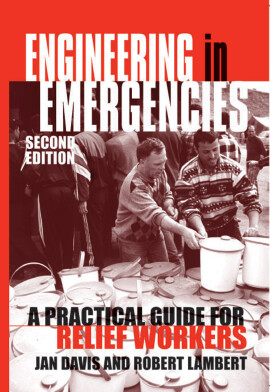

Engineering in Emergencies is a hugely successful practical handbook for all relief workers involved in giving humanitarian assistance. It provides the information needed to implement an effective engineering response in the aftermath of an emergency. The second edition of Engineering in Emergencies maintains the practical content of the first edition but has been revised and updated to reflect developments in humanitarian relief in recent years. The combination of 'hard' topics, such as water and sanitation, and 'soft' topics, such as managerial skills and personal effectiveness, has been retained from the original edition and the book expanded to include two new chapters on security and telecommunications. The new second edition will be available both as a book and as a handy CD-ROM, especially designed to be light and easily portable for relief workers in the field. Engineering in Emergencies is developed in collaboration with the agency RedR - Engineers for Disaster Relief, based in Westminster.
Published: 2002
Pages: 738
Engineering in Emergencies is a hugely successful practical handbook for all relief workers involved in giving humanitarian assistance. It provides the information needed to implement an effective engineering response in the aftermath of an emergency. The second edition of Engineering in Emergencies maintains the practical content of the first edition but has been revised and updated to reflect developments in humanitarian relief in recent years. The combination of 'hard' topics, such as water and sanitation, and 'soft' topics, such as managerial skills and personal effectiveness, has been retained from the original edition and the book expanded to include two new chapters on security and telecommunications. The new second edition will be available both as a book and as a handy CD-ROM, especially designed to be light and easily portable for relief workers in the field. Engineering in Emergencies is developed in collaboration with the agency RedR - Engineers for Disaster Relief, based in Westminster.
| Prelims (Contents, Contents in Detail, Acknowledgements, Introduction) |
|---|
| 1. Emergencies |
| 2. The humanitarian relief system |
| 3. Personal effectiveness |
| 4. Personal security |
| 5. Assessment and planning |
| 6. Management |
| 7. Logistics |
| 8. Telecommunications |
| 9. Environmental health |
| 10. Environmental sanitation |
| 11. Emergency water supply |
| 12. Water source development |
| 13. Water storage, treatment and distribution |
| 14. Pumps |
| 15. Mechanical plant |
| 16. Electrical plant |
| 17. Vehicles |
| 18. Roads, crossings and airstrips |
| 19. Shelter and built infrastructure |
| 20. Temporary settlements |
| Back Matter (Appendices 1 - 25, Bibliography, Index) |
[It is] very reassuring to have a reference book in the field which covers all aspects an engineer is expected to come across.
Water and sanitation engineer on assignment
Its use is highly recommended for all relief fieldworkers who have to deal with emergencies.
Disasters
This amazingly comprehensive book admirably covers a vast range of aspects the relief worker will deal with . an indispensible reference book.
New Civil Engineer
It contains a mass of fascinating information to help field engineers and others to undertake their tasks swiftly, methodically and effectively.
Water and Environmental Management
Praise for the first edition: 'this is an outstanding book and a major landmark in its field.'
John G. Evans, CIWEM.
Jan Davis Jan Davis is a chartered engineer with experience in both emergency relief and long-term development. He has worked for Oxfam as an emergency water engineer and is currently a Senior Training Officer responsible for delivering RedR’s training programme.
Robert Lambert Robert Lambert is Director of RedR. An engineer with over 15 years’ experience in Africa and elsewhere, he has extensive experience in selecting, preparing, training and debriefing a wide range of professionals for humanitarian relief work.